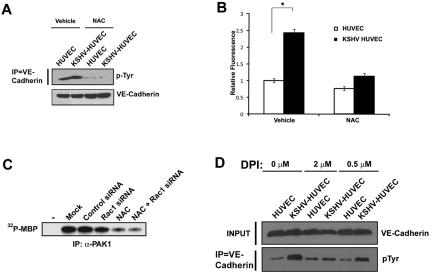Figure 6.
KSHV-induced endothelial permeability requires ROS production. (A) HUVEC and KSHV-HUVEC were treated with NAC (500μM) or vehicle control for 2 hours. VE-cadherin was immunoprecipitated and the immunoprecipitates were subjected to immunoblot analysis with an anti-phosphotyrosine antibody (clone 4G10). (B) HUVEC and KSHV-HUVEC were seeded in the upper well of a Transwell chamber and allowed to grow to confluence. After a 2-hour treatment with NAC (500μM), FITC-dextran (10 kDa) was placed in the upper well. The amount of FITC-dextran in the lower chamber was measured in a plate reader 6 hours later (P < .01; n = 3). (C) Rac1 and ROS affect PAK1 activity. Rac1 siRNA was transfected into KSHV-HUVEC. Cells were harvested 72 hours after transfection. Cells were treated with NAC for 2 hours before harvest. Cell lysates were subjected to immunoprecipitation with an anti-PAK1 antibody and kinase assays were performed. Rac1 siRNA transfected cells showed lower PAK1 kinase activity compared with control siRNA-transfected cells. In addition, NAC-treated KSHV-HUVEC and NAC treatment of Rac1 siRNA–transfected cells displayed the lowest level of PAK1 kinase activity. (D) HUVEC and KSHV-HUVEC were treated with DPI (0.5μM or 2μM) or vehicle control for 2 hours. VE-cadherin was immunoprecipitated and the immunoprecipitates were subjected to immunoblot analysis with an anti-phosphotyrosine antibody (clone 4G10).

